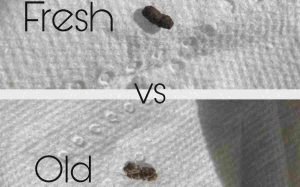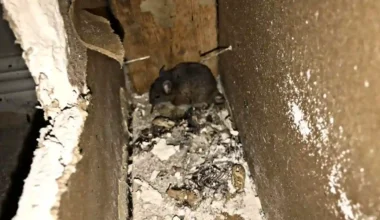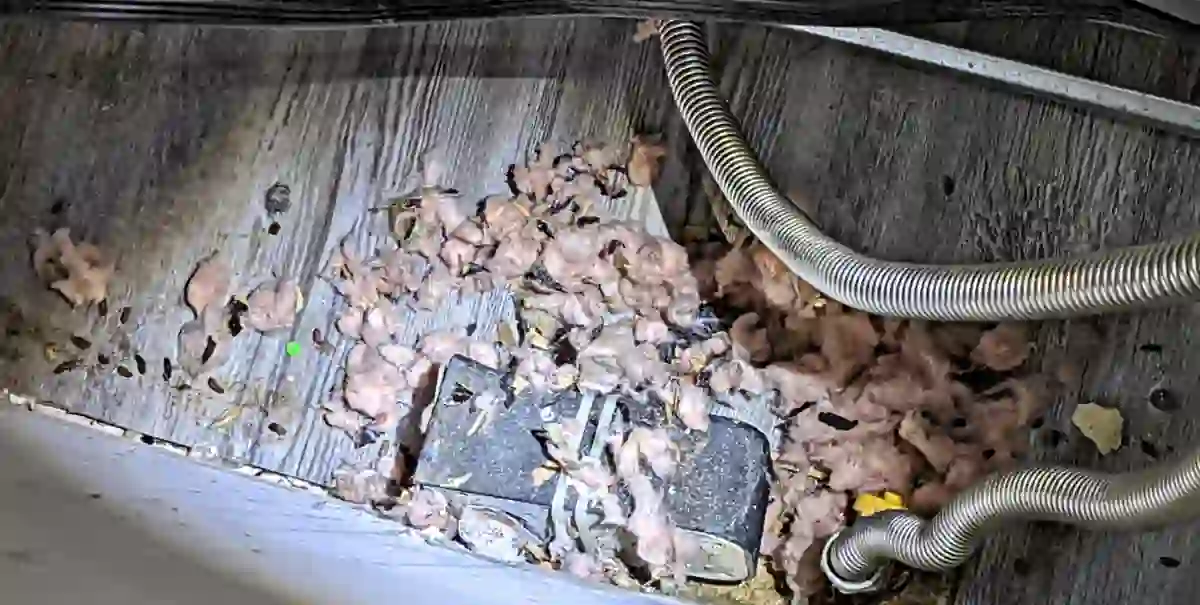You want to tell if mouse droppings are fresh when looking for evidence of a rodent infestation. Generally, the presence of droppings is one of the most common indicators that you may have mice lurking around. Mice can produce anywhere from 50-75 droppings per day, more than rats producing 40 to 50 droppings daily. That said if you find mouse droppings in your cupboard, kitchen cabinets, or basement, you may want to examine its freshness to determine the extent and type of infestation.
What does mouse dropping look like?

Homeowners often mistake mouse droppings for those of other pests, including rats or bats. Both rat and mouse droppings are roughly cylindrical and dark in color. However, rat poop is generally larger than mouse poop, with a length of up to half an inch compared to one-eighth to one-quarter of an inch for mouse droppings. Moreover, rats produce fewer droppings per day than mice, with about 50 droppings on the high end, but on the low end for mice.
Mouse droppings are also more tapered at the end, resembling rice. Although bat poop may resemble mouse poop, it is generally more crumbly and may contain shiny bits of exoskeleton from the insects bats eat, making the appearance glittery under good lighting conditions, as described by 2 New Things experts.
How to tell if mouse droppings are fresh
Fresh mouse droppings may indicate an active infestation in the area where you find them. Be careful with the examination or have experts tell whether the droppings are fresh or old. Consider the following during the examination:
1. Wet appearance
When mouse droppings are fresh, they appear wet and moist on the surface. As they age, the moisture evaporates and the droppings take on a dry, dusty appearance. Note also that older mouse poop could be wet due to other factors like the presence of moisture in the environment where the poop is left, or the fact that mice can produce a small amount of urine when they defecate.
2. Soft poop texture
You can tell they’re fresh mouse droppings if they are soft and squish when pressure is applied. Older droppings are harder and will crumble when crushed.
Note, however, that mice are possible carriers of the hantavirus, which is a pathogen that can cause severe respiratory illness in humans. Hantavirus spreads through the inhalation of aerosolized particles from mouse poop. Thus, make sure to wear personal protective equipment (PPE) when handling mouse droppings to avoid the risk of infection—do not touch mouse poop with your bare hands. If you do handle mouse droppings while wearing PPE, go ahead and squish to tell their age by the texture.
3. Dark, vibrant black color
Fresh mouse droppings are typically dark, vibrant black in color. As the poop ages, it may fade in color and become crumbly or pulverized, as mentioned earlier.
Within 48-72 hours, mouse droppings should appear faded and old. You can differentiate between old and new droppings using the “squish test” suggested earlier to determine their texture.
Note that rodent droppings can vary in colors, including black, brown, green, and more. This variation depends on what the mice have been consuming. For example, if a mouse has been rodenticide bait, its droppings are likely to be influenced by the color of the bait.
How long do mouse droppings remain infectious?
Hantavirus in mouse droppings may remain infectious for 2 to 3 days at room temperature, but exposure to sunlight can decrease the time that the virus remains viable, while freezing temperatures can increase the time that the virus remains infectious, per the State of New Jersey.
Apart from hantavirus, mouse droppings can contain several different types of bacteria and viruses that can be harmful to humans, including Salmonella, E. coli, Lymphocytic choriomeningitis virus (LCMV), and Leptospira bacteria. These pathogens can remain infectious in mouse poop for different periods of time depending on various factors, such as:
- the type of pathogen
- the humidity and temperature of the environment, and
- the amount of sunlight the droppings are exposed to.
That said, it’s advisable to assume that mouse droppings are potentially infectious and take appropriate precautions to avoid direct or indirect contact with them. Consider wearing personal protective equipment, such as gloves and a face mask, when handling droppings. Also, disinfect any surfaces that may have come into contact with the poop.
If you are unsure about the risk of infection from mouse droppings, do not hesitate to consult with a healthcare professional or pest control expert.
Where would you find mice droppings?
Mice prefer those areas of the house where they can find food and shelter. Some common places you would find mouse droppings include the sofa, kitchen cabinets and pantries, utility closets, and nearby areas where mice may find nesting materials, such as your closets.
Mouse droppings would also be found in corners and along baseboards, as mice have poor vision and prefer to stay close to walls when moving around. Keep in mind that mice are looking for food and shelter, so be sure to check places where they may find these necessities.
What to do if you find mouse droppings
Follow these safety tips to get rid of mouse droppings:
1. Ventilate the area
Ventilate the area by opening windows or using fans to introduce fresh air into the area for about 30 minutes to help remove contaminated particles from the air.
2. PPE yourself
When cleaning up mouse droppings, make sure to wear protective gear such as a long-sleeve shirt, gloves (rubber or plastic gloves are recommended, per the Centers for Disease Control and Prevention, CDC), and a mask to prevent any potential indirect exposure to harmful bacteria or viruses that may be present in the poop. After cleaning, you’ll have to remove the gloves and wash your hands and clothes thoroughly with soap and warm water to prevent any contamination. Consider disposing of the gloves as well.
3. Disinfect contaminated surfaces
It’s recommended to mix a solution of 1 part bleach to 10 parts water or use your daily household disinfectant. Spray the solution onto hard surfaces. Try to cover the entire area and allow the disinfectant to sit for up to 5 minutes.
You may have to dispose of any contaminated cardboard or other materials in a plastic bag for your safety and the safety of others in the apartment.
4. Pick the droppings
You need to clean up droppings by carefully picking them up with a paper towel. Dispose of the droppings in a sealed plastic bag. Do not sweep or vacuum the mouse poop. Continue spraying and wiping down contaminated surfaces until the area is fully disinfected.
If there is any exposed clothing, you should wash them with your 1:10 bleach solution or household disinfectant. Make sure to also hand wash your exposed towels and bedding or put them in the washing machine. Use mild soap and set the water to the hottest possible (if using a washing machine). If handwashing, use warm water.
Note: vinegar is not a reliable disinfectant when dealing with mice droppings.
5. Get rid of nesting materials
If you spot mice nest around, spray it with the bleach water solution or a disinfectant and wait at least 5 minutes. Gently pick and place the nest and nesting materials in a plastic bag with your gloves on. Consider doubling the bag and sealing it before disposing of the contaminated waste in a covered trash can.
If you eventually capture a live mouse, do refer to this detailed guide on safe mice release back into the wild.
Conclusion
Apart from potentially spreading disease, mice presence could also lead to severe property damage when they rip up insulation for nesting materials and chew through electrical wires in your home. You may need to consider the services of professional exterminators to remove the droppings, get rid of mice, and mice-proof your property against future entry. Don’t hesitate to make that call to your local mouse control expert.






